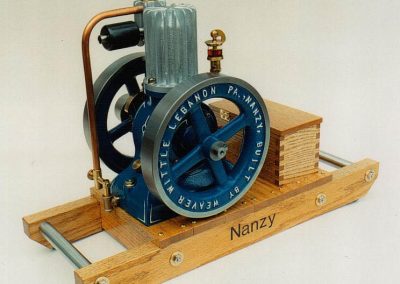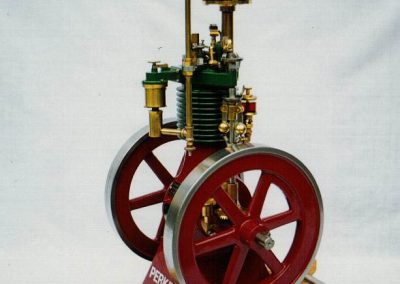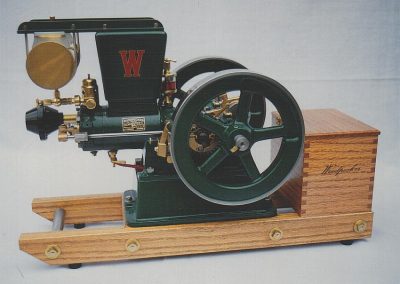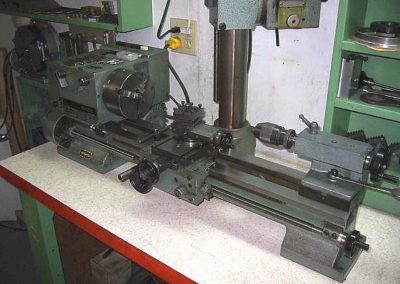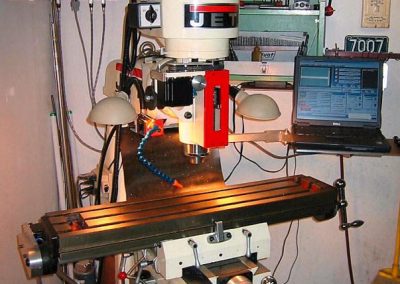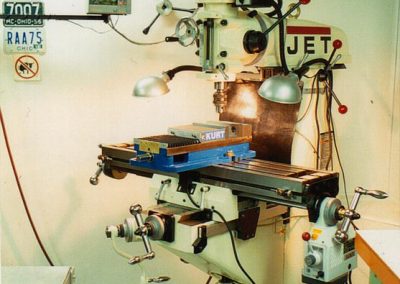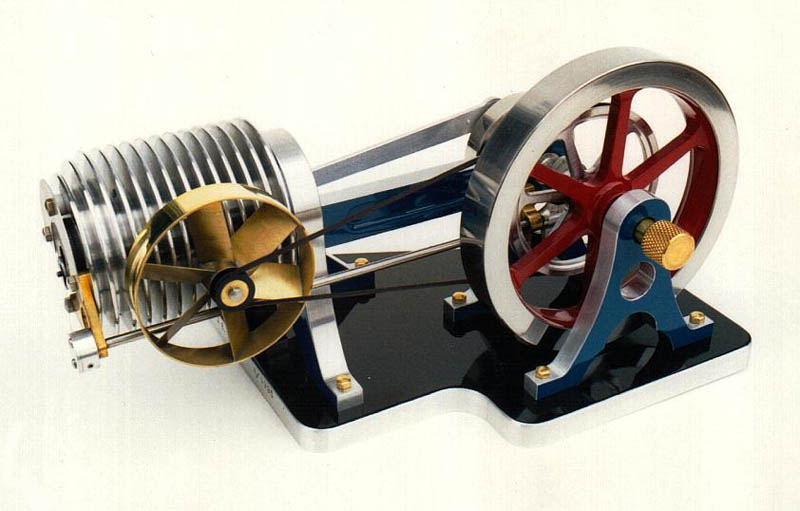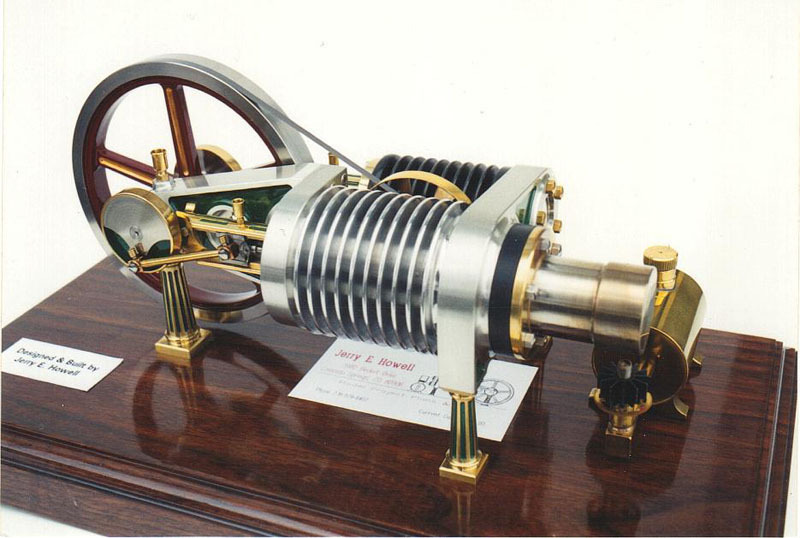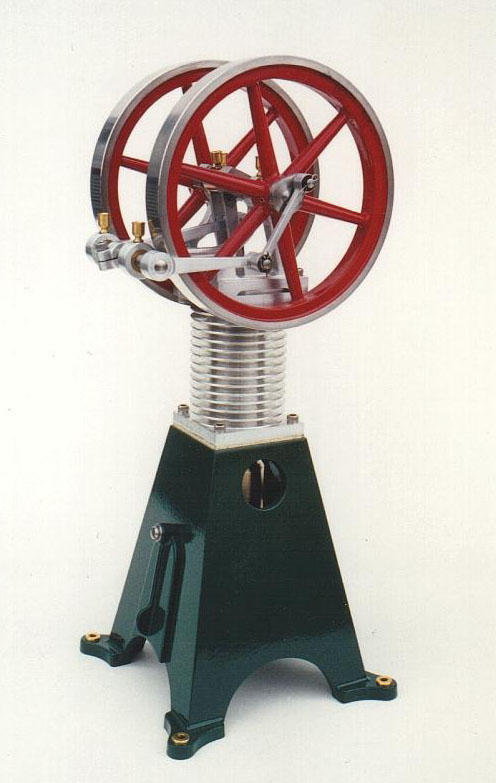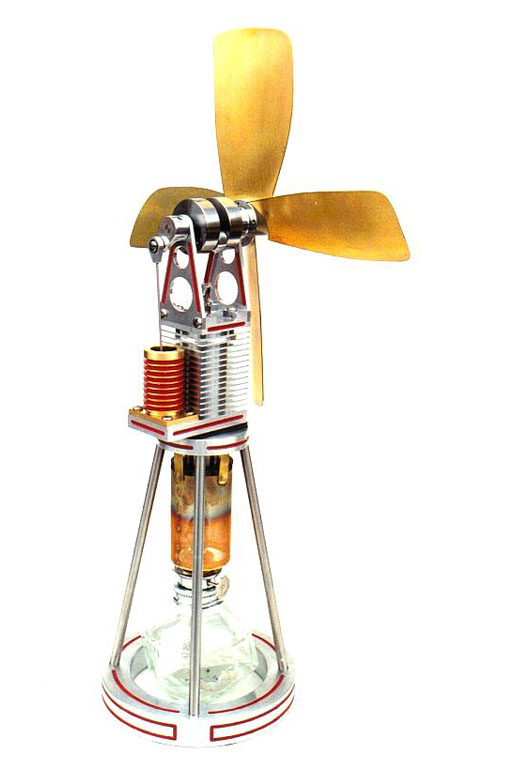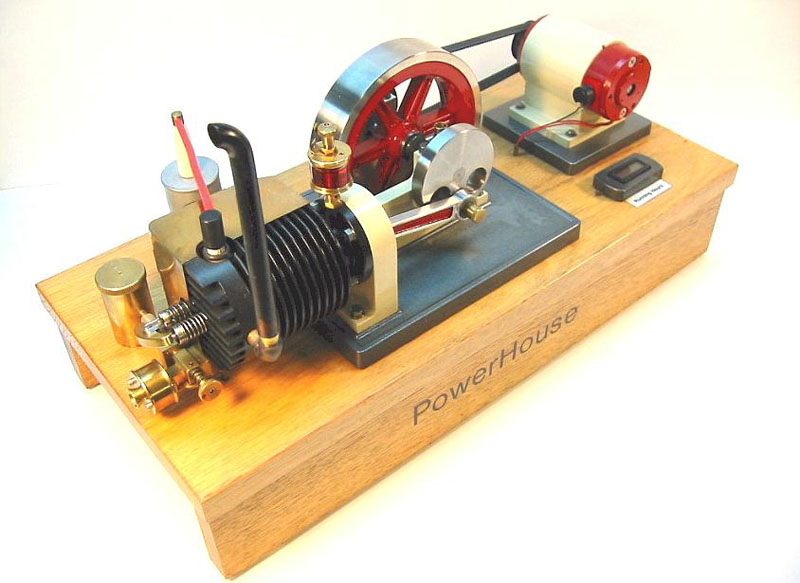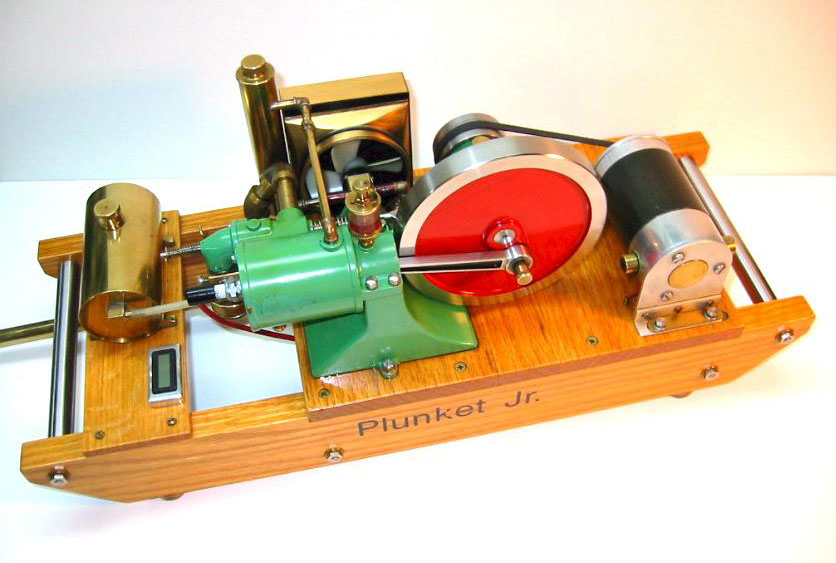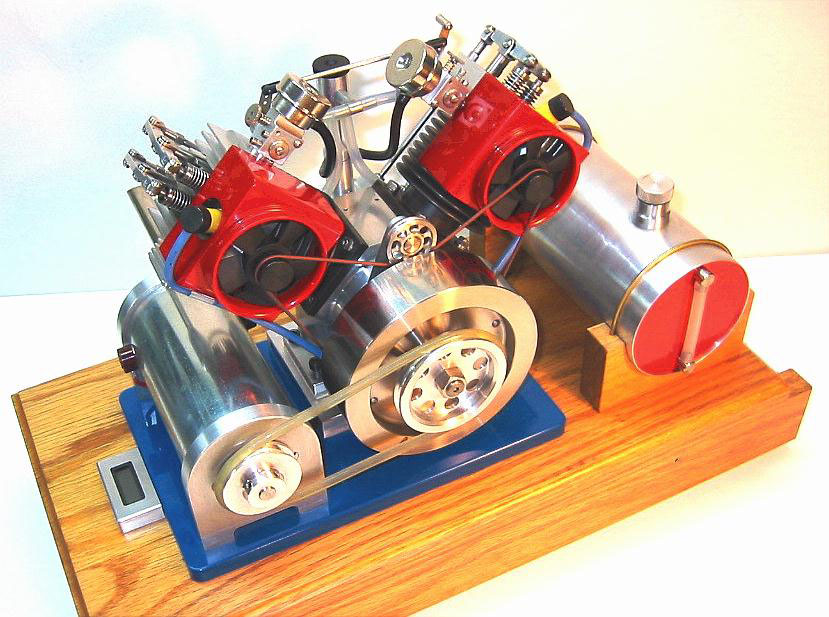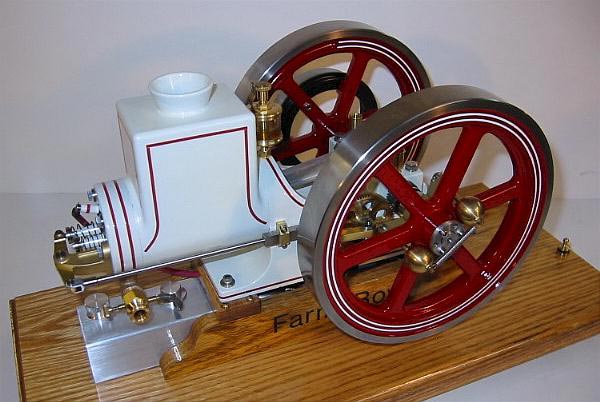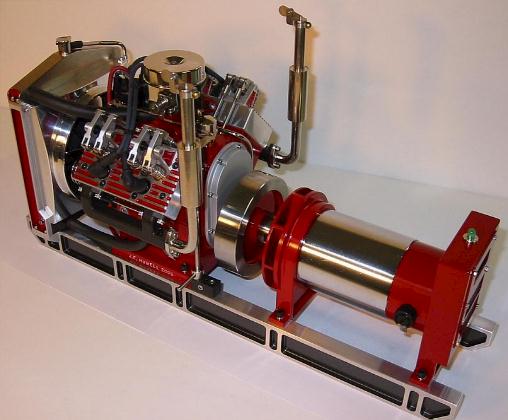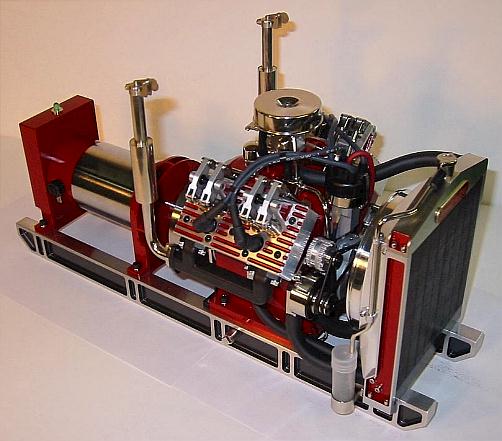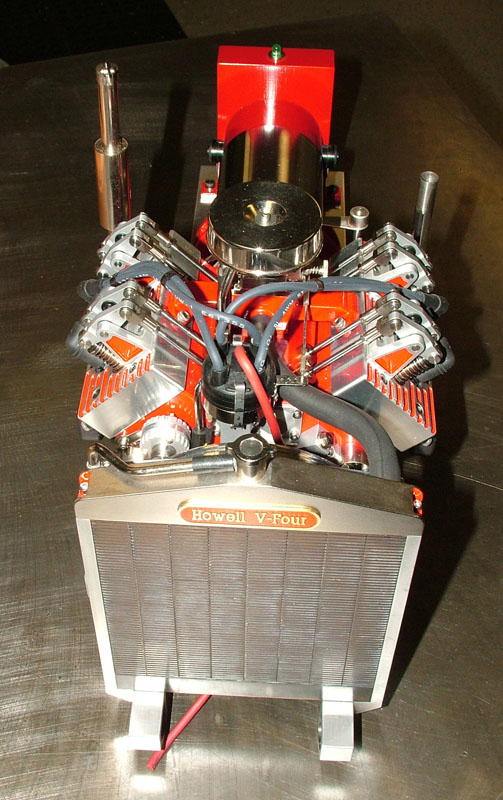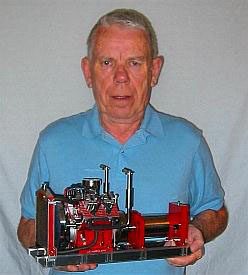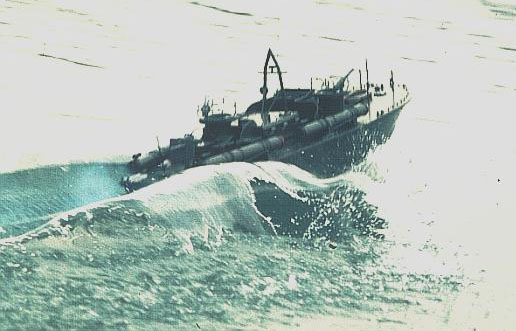Below you can view more photos of Jerry Howell’s scale engines. Click on images to enlarge.
Engines and Shop Tools
Nanzy Engine
This 1/2 horsepower Nanzy engine was machined from 1/2 scale castings in a kit by Russell Snyder. The engine has a 1-1/8” bore, 1-1/2” stroke, and 6” flywheels. Jerry made babbitt crankshaft bearings instead of bronze. He also installed a positive crankcase vent check valve inside the crankcase.
Perkins Windmill Engine
This engine was machined from a set of castings made by DeBolt Machine. The crankshaft was machined from solid tool steel. The valves, governor shaft, and fuel pipe support bracket are stainless steel. It uses a low-tension, make-n-break ignition.
Jet JVM-836 Mill With CNC
This is the Jet JVM-836 on which Jerry installed ball lead screws, and converted to CNC. The control electronics are mounted on the wall in the upper left of the photo. Jerry designed his own flood coolant system, which is on the left side of the mill frame off the floor. He ran Mach 3 control software on a laptop to the right that fed g-code to the controller.
Jerry Howell Designed Engines
The following engines were all designed and built by Jerry.
This 4-in-1 vacuum engine (or “atmospheric” engine) is fan cooled, and made from bar stock (no castings). It’s commonly called a “Flame Eater.” The engine features a torsion rod type valve mechanism, graphite valve seat, stainless steel cylinder liner, and graphite piston. The flywheel is 4” in diameter. An atmospheric engine can be built four ways: It can have an air cooled side crank, an air cooled center crank, or a water cooled side or center crank. The air cooled engines have an optional belt-driven cooling fan, which helps to cool during long running sessions. The engine still runs fine without this fan; however, with the fan in use the engine will run all day long and never get hot. Long runs or not, the fan adds an interesting element. All four versions of this engine use Jerry’s oscillating (twisting) side shaft mechanism to operate the head valve. His unique valve seat is made of self-lubricating, non-metallic material. This greatly reduces valve sliding friction, and virtually eliminates wear. The engine speed range is from 60-600 rpm.
This entire engine is made from bar stock. The flywheel is 4.625” in diameter. Stirling engines have no valves, carburetor, ignition system, or boilers. The silence when they run is almost ghostly. When properly made, they will run flawlessly any time a source of heat is applied. Named “Vickie,” this is a Stirling cycle engine modified from a Heinrici type. It has elegant Victorian styling that was typical of 18th-19th century engines and machines. The engine has three fluted, columnar legs and two different style crossheads. They blend perfectly with the curved and angular lines of the engine frame. A belt-driven brass cooling fan competes with the rod and crosshead action for attention. Vickie is powered by an attractive horizontal brass alcohol burner, which sports an integral fuel level sight glass.
This “Duplex” is not a true vacuum engine, rather it’s a beta type Stirling engine. Beta means that the power piston and the displacer are both working in the same cylinder. This arrangement creates greater power output than the typical two-cylinder engine. That’s because the compression ratio can be higher due to less dead space inside the engine. Jerry’s design was named after The Duplex Vacuum Company of Chicago, which created the original engine about 100 years ago. They were widely used in popcorn wagons, and to operate dental drills (among other applications), because of their silent operation and reliability. A unique feature of the Duplex engine is the oscillating shaft and linkage which produces an interesting motion while operating the displacer.
This fan was designed to be a real workhorse. Every effort was made to reduce friction to an absolute minimum, while also making the unit extremely reliable, maintenance free, quiet, and long lasting. Jerry’s fan had run for hundreds of hours while at shows, or sitting in his office during summer months. Despite that, it never needed any maintenance, service, or repairs of any kind. In addition to the crankshaft running in ball bearings, the power piston rod is also fitted with precision ball bearings. All of the reciprocating parts use very low friction, non-metallic components, and never need to be oiled. The hot cap was specially designed to absorb heat from the flame. The carefully shaped and angled concave fan blades improve overall efficiency.
This 4-cycle engine, named “PowerHouse,” was made entirely from bar stock. It powers a DC generator which also acts as a starter motor. The generator powers an electric cooling fan in the air shroud, runs an hour meter, keeps the ignition battery charged, and also powers external loads. This engine was run for over 300 hours. The flywheel is 4.650″ in diameter.
The “Plunket Jr.” is a 1/2 scale, 4-cycle engine. This was also Jerry’s first bar stock IC engine. It has a water pump, fan/radiator, and powers a DC generator which is also the starter motor. The flywheel is 5” in diameter. The rectangular unit near the fuel tank is an hour meter, operated by the generator. This engine was run for over 900 hours.
This Howell V-Twin was also made entirely from bar stock. It’s a 4-cycle, fan cooled, 90-degree engine with a 1” bore and 1.25” stroke. An electric fuel pump in the base supplies fuel from the 20-ounce methanol tank. The valve timing gears are pressure lubricated. The DC generator, which is also the starter motor, can power a large external load.
Jerry’s “Farm Boy” hit-n-miss engine has a 1” bore, and 1-3/8” stroke. The engine frame, water hopper, and head are aluminum alloy. The one-piece crankshaft was made from Starrett tool steel. The 6″ diameter flywheels were machined from cast iron disks. The engine will coast from 20 to 28 revolutions between firing.
Jerry’s namesake Howell V-4 engine. Pressure lubrication to the rod ends happens via an external gear oil pump, which feeds oil through the drilled crankshaft. There is an oil pressure adjuster and an oil pressure gauge port. The engine is water cooled using Jerry’s unique magnetic drive water pump. It has no seals to leak, and a proper looking and effective shop made radiator.
All external parts are sealed using “O” rings, which prevent any oil seepage from the engine. A crankcase vent/check valve maintains negative crankcase pressure. A dipstick is provided to monitor the oil level, and also an easy access oil drain plug.
This engine was chosen to be the Joe Martin Foundation’s second shop build project. See the Howell V-4 engine page for details on the project, as many craftsmen worked to build this engine in our home shop. Jerry is shown here holding his finished prototype, lending a better sense of size to the engine.
R/C PT-109 Model
In 1968, Jerry built this radio-controlled model of PT-109 from a Fibo Craft kit. The hull is fiberglass, and the major deck structures are wood. The deck also has white metal castings, and the torpedo tubes are aluminum tubing with red ping pong ball noses. The boat is 39”-long, and weighs around 10 lbs. It was powered by one of the first O.S. Wankel engines of the time. The engine is .29 cubic inches displacement (about 5 cc). It was fitted with a stainless steel flywheel and a brass water jacket. A water pickup was fitted behind the propeller. After circulating through the engine jacket, cooling water was discharged into the exhaust pipe ahead of the muffler. The tailpipe exits through the transom. A puff of white castor oil smoke and steam vapor can be seen in the photo. The boat was equipped with two 8-ounce fuel tanks, one on each side of the prop shaft stuffing tube. The fuel pump was belt driven from the prop shaft.

